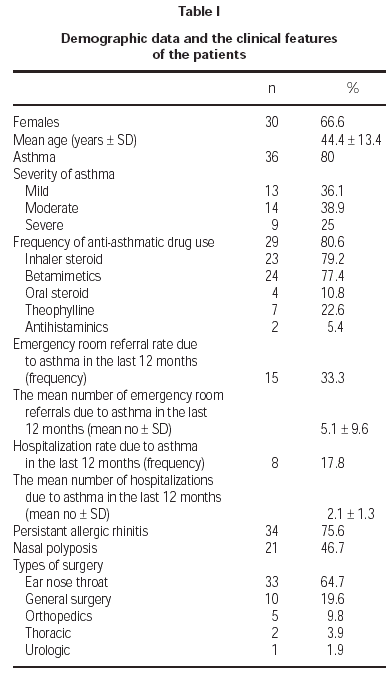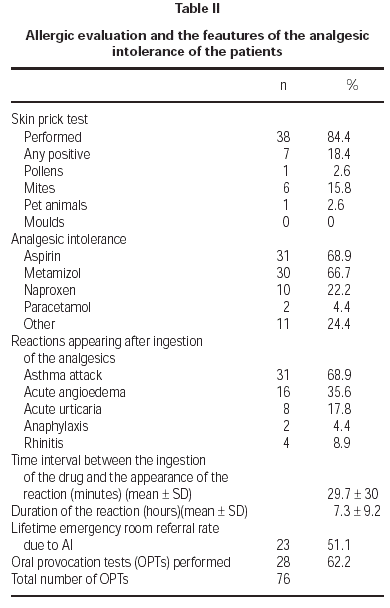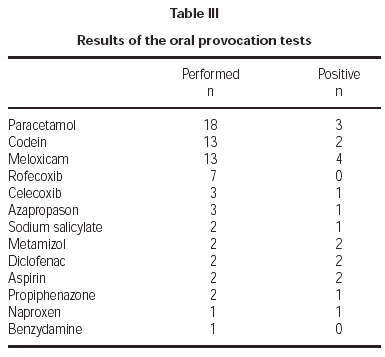INTRODUCTION
Although the prevalence of analgesic intolerance (AI) is about 1 % in general population, it rises up to 10-20 % in adult asthmatics1,2. The triad of asthma, nasal polyposis and analgesic intolerance has been called aspirin-induced asthma or analgesic-induced asthma (AIA)1-5. The most bothersome issue about these patients is the dogma in most of the physicians' mind that AIA/AI patients could also be intolerant to general anesthetic agents. This uncertainty sometimes leads to the postponement of an important operation and sometimes the performance of unnecessary, time-consuming and expensive serologic allergy tests with low sensitivity and specificity.
Although it is not known if there is a relation between AI/AIA and surgery and/or general anesthesia, there are some data that asthmatic patients can have intra and/or postoperative complications6-8. Nearly 18,000 day care surgical patients were enrolled in a survey, which showed that these patients had an approximately five-fold increase in the risk of developing postoperative respiratory adverse events7. Adverse events included unanticipated postoperative admission to intensive care unit or hospital ward, prolonged postoperative stay and unscheduled return hospital visits7,8.
In general, benzodiazepines are the most satisfactory agents for sedation in asthma6. The cornerstone of general anesthesia is a smooth induction avoiding drugs with histamin releasing property. Propofol and etomidate are suitable agents for this purpose. Vecuronium bromide is the muscle relaxant of choice. Volatile anesthetics with their bronchodilating properties can safely be used for the maintenance of anesthesia. Reversal of nondepolarizing neuromuscular blocking agents with anticholinesterase does not precipitate bronchoconstriction if preceded by appropriate dose of an anticholinergic. Extubation must be performed under deep general anesthesia to avoid bronchospasm6.
A marked cross sensitivity with other NSAIDs which may precipitate bronchospasm and adverse reactions is the main problem for the anesthesiologists regarding pain management in AI patients with/without asthma. Unfortunately, all the NSAIDs favoured currently by anesthesists (including diclofenac, ibuprofen, indomethacin, ketoprofen, ketorolac and piroxicam, metamizole) are potent cyclooxygenase inhibitors which are implicated in this problem1-6,9,10. Analgesics causing histamine release such as morphine and meperidine may precipitate bronchospasm and other allergic reactions in susceptible patients6. Fentanyl, a potent narcotic analgesic is used for early postoperative pain relief, whereas safe alternative analgesics suggested by allergists are preferred for the late ones.
The aim of this survey was to determine the general anesthesia and postoperative pain management related allergic problems in AI patients with/without asthma, who have been evaluated by an allergist preoperatively and received a special general anesthesia protocol used for the asthmatic patients by the anesthesiology department of our hospital in the last four years.
METHODS
The medical records of 45, out of 660 patients who had been diagnosed as AI and AIA between January 1991-December 2002 in the department of chest diseases, adult allergy unit and have been operated in the hospital in the last 4 years under general anesthesia were investigated and analyzed retrospectively.
A standard questionnaire was filled-in by an allergologist for all the patients. The collected data was about the age, gender, bronchial asthma, persistant allergic rhinitis11, AI, nasal polyps and features of AI [analgesic(s) causing intolerance, latent period between the drug ingestion and the beginning of the reaction, the reactions emerged, duration of the reaction].
The diagnosis of asthma was made by history depending on the international guidelines12 The diagnosis of AI and AIA were based on detailed clinical history. Sufficient and reliable clinical history of at least two events with aspirin and/or other analgesics was required for diagnosis of AI. The reaction should have occurred within three hours after the ingestion of the analgesic. If there was only one event, then confirmation by oral provocation test was required. Oral provocation tests were performed as described before10. Physical examination, chest radiography and pulmonary function testing were performed in all the patients. Bronchodilatation test and methacholine airway challenge were also performed when indicated. AIA was diagnosed if the patient had at least AI and asthma.
Routine skin prick tests were performed to all the patients except for the ones who were pregnant, or had chronic urticaria and/or dermographism or used antihistaminic at the time of the test. Thirteen standard antigen solutions (dermatophagoides pteronyssinus, phleum pratense, olea europa, artemisia vulgaris, parieteria officinalis, hazelnut, betula verrucosa, cat, dog, horse, alterneria alternata, cladosporium herbarum and latex) were used which were prepared by ALK (Denmark) and Greer (USA) companies. The standard antigen solutions were applied and the results were interpreted as described before 13 Atopy was defined as a positive reaction to any one of the allergens.
A standard anesthesia protocol basically concerning asthmatic patients was administered to all of the patients by the anesthesiology department. Benzodiazepines for preoperative sedation, propofol and fentanyl for induction of anesthesia, vecuronium bromide for muscle relaxation, isoflurane or sevoflurane for the maintenance were the drugs of choice. The peroperative and postoperative follow-up records of the 45 patients were investigated and analyzed by an anesthesiologist.
RESULTS
Demographic data and the clinical features of the 45 patients who underwent operations are shown in table I. Fifty-one surgical procedures were applied to 45 patients. Highest incidence of surgical approach concerned ear-nose-throat surgery. Allergic evaluation and the features of the analgesic intolerance of the patients are shown in table II. Results of the oral provocation tests are given in table III. Nine patients had only one adverse event with analgesics and 8 of the 9 oral provocation tests with the suspected analgesics, which were performed to confirm the diagnosis, were positive.
The preoperative allergic assessment, achieving optimal pulmonary function and choosing suitable analgesic drug alternatives provided a safe anesthetic management with no preoperative and intraoperative complications. Only a 46-year-old woman with AIA operated for bilateral cervical outlet syndrome, who has been given metamizol, had been followed up in the intensive care unit due to atrial fibrillation, and acute urticaria.
DISCUSSION
Patients were middle-aged and the majority were females, which are compatible with the results of the previous reports1,2,4,5. Since 80 % of the patients had asthma and two thirds of these were moderate-severe in degree, we did not perform oral challenge for reconfirmation to all patients for ethical reasons, if the clinical history was satisfactory. In accordance with the previous papers reporting that persistant allergic rhinitis, pansinusitis and nasal polyposis commonly accompany AIA, two thirds of our cases have undergone ear nose throat operations1-5,10,11. The preoperative allergic assessment of the patients concerned pulmonary function tests as well as oral provocation tests to determine safe alternative analgesics, but no special tests have been applied for safe anesthetic agents.
In general, drugs, which do not induce histamine release preceding bronchospasm, are the agents of choice in asthmatic patients6. Among those we preferred benzodiazepines for premedication, propofol and fentanyl for induction, vecuronium bromide to facilitate muscle relaxation, isoflurane and sevoflurane for maintenance of general anesthesia, and fentanyl for the early postoperative pain relief.
The patients generally had moderate or severe asthma, which is also supported by the data about the emergency room referral and hospitalization rates and the antiasthmatic medications they have been using. As no complications were noted related to general anesthesia and the pain management method, although most of the patients had moderate-severe asthma, the agents can be assumed suitable for AIA patients.
Although contraindication for metamizol application was noted in her file, it was administered to a patient for postoperative pain relief two hours after leaving post anesthetic care unit depending on the information the patient had given. This 44-year-old woman having AIA was admitted to the intensive care unit because of acute urticaria and arrhythmia and followed up over a night. We must bare in mind that the data about the safe drugs must be taken from the suggestions of the allergists in the file instead of the patient himself/herself, because general anesthesia may cause a loss in cognitive functions for several hours or even days6.
In conclusion, the patients did not have any anesthesia related problems no matter what type of surgery they have undergone as the result of the preoperative evaluation and preparation of AI patients with/without asthma in collaboration with allergy and anesthesiology clinics and the suitable anesthetic approach. Atropine and diazepam in the premedication, propofol and fentanyl during induction, muscle relaxation facilitation by vecuronium, and sevoflurane or isoflurane for maintenance seem to be the safe general anesthetic choice for AI patients with/without asthma.









